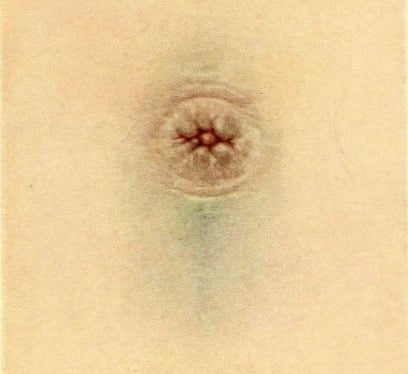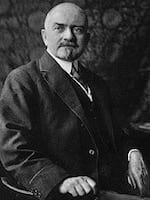Thomas S. Cullen
Thomas Stephen Cullen (1869-1953) was a Canadian gynecologist.
Johns Hopkins gynecologist, a pioneer in the development of gynecological pathology as a speciality. Eponymously affiliated with Cullen sign (1918)
Research focused on cancer and adenomyoma of the uterus, hyperplasia of the endometrium, diseases of the umbilicus and extrauterine pregnancy
Biography
- Born on November 20, 1868 in Bridgewater, Ontario
- 1890 – Medical degree, University of Toronto
- 1891 – Johns Hopkins under William Welch in the pathology laboratory before beginning an internship in gynaecology with Howard Kelly
- 1893 – Gynaecological pathologist, Johns Hopkins
- 1897 – Associate in gynaecology, Johns Hopkins
- 1910 – Helped found the Department of Art as Applied to Medicine, Johns Hopkins University School of Medicine
- 1919 – Professor of clinical gynaecology, Johns Hopkins
- Died on March 4, 1953
Medical Eponyms
Cullen sign (1918)
Superficial oedema with bruising in the subcutaneous fatty tissue around the peri-umbilical region.
Cullen originally described as a new sign in ruptured extrauterine pregnancy and described the finding at the 43rd annual meeting of the Transactions of the American gynecological society, Pennsylvania May 16-18, 1918
The patient, a woman, thirty-eight years of age, suddenly developed abdominal pain and distention. Dr. Cullen saw her three weeks later. The umbilical region was bluish black, although she gave no history of injury. Vaginal examination yielded nothing on account of the abdominal distention. Under ether, however, a mass 8 X 6 cm. was clearly felt to the right of the uterus. Dr. Cullen at once diagnosed extrauterine pregnancy, although the patient had missed no period and there was no uterine bleeding. On opening the abdomen he found a right-sided extrauterine pregnancy and about one and a half quarts of free blood in the abdomen.
Cullen TS, 1918
Cullen expanded on this report in Contributions to Medical and Biological Research, a two volume tome dedicated to Sir William Osler on the occasion of his seventieth birthday on July 12, 1919.
Bearing Dr. Ransohoff’s 1905 case in mind I dictated the following note prior to opening the abdomen: “The bluish black appearance of the navel unassociated with any history of injury, together with the mass to the right of the uterus, makes the diagnosis of extrauterine pregnancy relatively certain.”
I record this case in order that subsequent ruptured extrauterine pregnancies may be examined for this sign. Whether it will prove to be of common occurrence or very rare, I cannot say, but we shall naturally expect it only where there is free blood in the abdomen and shall probably be more likely to encounter it in thin individuals.
Cullen TS 1919

Cullen 1919: 420-422
Major Publications
- Cullen TS. Pyometra in a cat… American veterinary review, September. 1894
- Cullen TS. Silkworm gut as a subcutaneous suture in closure of abdominal incisions. American journal of obstetrics, 1897; 36(2): 171-175
- Cullen TS. Cancer of the uterus: its pathology, symptomatology, diagnosis, and treatment : also the pathology of diseases of the endometrium. 1900
- Cullen TS. Adenomyoma of the Uterus. 1908
- Cullen TS. Embryology Anatomy and Diseases of the Umbilicus Together With Diseases of the Urachus 1916.
- Cullen TS. A new sign in ruptured extrauterine pregnancy. American journal of obstetrics and diseases of women and children. 1918; 78: 457 [Cullen Sign]
- Cullen TS. Bluish discolouration of the umbilicus as a diagnostic sign when ruptured extrauterine pregnancy exists. In: Contributions to Medical and Biological Research. 1919; 1: 420-422 [Cullen Sign]
References
Biography
- Martzloff KH. Thomas Stephen Cullen. Am J Obstet Gynecol. 1960; 80: 833-43.
- Bibliography. Cullen, Thomas Stephen 1868-1953. WorldCat Identities
Eponymous sign
- Harris S, Naina HV. Cullen’s sign revisited. Am J Med. 2008; 121(8): 682-683.
- Rahbour G, Ullah MR, Yassin N, Thomas GP. Cullen’s sign – Case report with a review of the literature. Int J Surg Case Rep. 2012; 3(5): 143–146.
- McKennedy C. Cullen sign: Eponym A Day. Instagram
- Cadogan M. Non-traumatic Abdominal Ecchymosis. LITFL
[cite]

